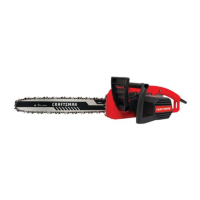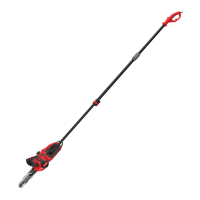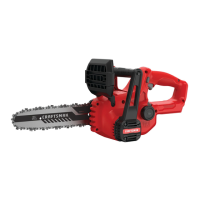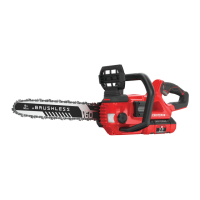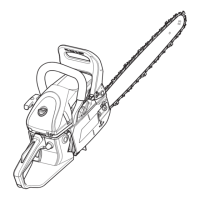ENGLISH
4
• Kickback, Pinch -
The rapid pushback of the saw which
can occur when the wood closes in and pinches the
moving saw chain in the cut along the top of the guidebar.
• Kickback, Rotational - The rapid upward and backward
motion of the saw which can occur when the moving saw
chain near the upper portion of the tip of the guide bar
contacts an object, such as a log orbranch.
• Limbing - Removing the branches from a fallen tree.
• Low-Kickback Chain - A chain that complies with the
kickback performance requirements of ANSI B175.1–2012
(when tested on a representative sample of chain saws.)
• Normal Cutting Position - Those positions assumed in
performing the bucking and fellingcuts.
• Notching Undercut - A notch cut in a tree that directs
the tree’sfall.
• Rear Handle - The support handle located at or toward
the rear of thesaw.
• Reduced Kickback Guide Bar - A guide bar which has
been demonstrated to reduce kickbacksignificantly.
• Replacement Saw Chain - A chain that complies with
kickback performance requirements of ANSI B175.1–2012
when tested with specific chain saws. It may not meet
the ANSI performance requirements when used with
othersaws.
• Saw Chain - A loop of chain having cutting teeth, that
cut the wood, and that is driven by the motor and is
supported by the guidebar.
• Ribbed Bumper - The ribs used when felling or bucking
to pivot the saw and maintain position whilesawing.
• Switch - A device that when operated will complete or
interrupt an electrical power circuit to the motor of the
chainsaw.
• Switch Linkage - The mechanism that transmits motion
from a trigger to theswitch.
• Switch Lockout - A movable stop that prevents
the unintentional operation of the switch until
manuallyactuated.
bars and chains may cause chain breakage and/
orkickback.
d ) Follow the manufacturer’s sharpening and
maintenance instructions for the saw chain.
Decreasing the depth gauge height can lead to
increased kickback.
Kickback Safety Features
WARNING: The following features are included
on your saw to help reduce the hazard of kickback;
however such features will not totally eliminate this
dangerous reaction. As a chain saw user do not rely
only on safety devices. You must follow all safety
precautions, instructions, and maintenance in this
manual to help avoid kickback and other forces which
can result in seriousinjury.
• Reduced-Kickback Guide Bar, designed with a small
radius tip which reduces the size of the kickback
danger zone on bar tip. A reduced - kickback guide
bar is one which has been demonstrated to significantly
reduce the number and seriousness of kickbacks when
tested in accordance with safety requirements for electric
chainsaws.
• Low-Kickback Chain, designed with a contoured
depth gauge and guard link which deflect kickback
force and allow wood to gradually ride into the
cutter. A low-kickback chain is a chain which has met
kickback performance requirements of ANSI B175.1–2012.
Chainsaw Names and Terms
• Bucking - The process of cross cutting a felled tree or log
intolengths.
• Motor Brake - A device used to stop the saw chain when
the trigger isreleased.
• Chain Saw Powerhead - A chain saw without the saw
chain and guidebar.
• Drive Sprocket or Sprocket - The toothed part that
drives the sawchain.
• Felling -
The process of cutting down atree.
• Felling Back Cut -
The final cut in a tree felling operation
made on the opposite side of the tree from the notchingcut.
• Front Handle - The support handle located at or toward
the front of the chainsaw.
• Front Hand Guard - A structural barrier between the
front handle of a chain saw and the guide bar, typically
located close to the hand position on the fronthandle.
• Guide Bar - A solid railed structure that supports and
guides the sawchain.
• Scabbard/Guide Bar Cover - Enclosure fitted over guide
bar to help prevent tooth contact when saw is not inuse.
• Kickback - The backward or upward motion, or both
of the guide bar occurring when the saw chain near the
nose of the top area of the guide bar contacts any object
such as a log or branch, or when the wood closes in and
pinches the saw chain in thecut.
Additional Safety Information
WARNING: Never modify the power tool or any part
of it. Damage or personal injury couldresult.
WARNING: ALWAYS use safety glasses. Everyday
eyeglasses are NOT safety glasses. Also use face or
dust mask if operation is dusty. ALL USERS AND
BYSTANDERS MUST ALWAYS WEAR CERTIFIED
SAFETYEQUIPMENT:
• ANSI Z87.1 eye protection (CAN/CSA Z94.3),
• ANSI S12.6 (S3.19) hearing protection,
• NIOSH/OSHA/MSHA respiratoryprotection.
WARNING: Some dust created by power sanding,
sawing, grinding, drilling, and other construction
activities contains chemicals known to the State
of California to cause cancer, birth defects or
other reproductive harm. Some examples of these
chemicalsare:
• lead from lead-based paints,
